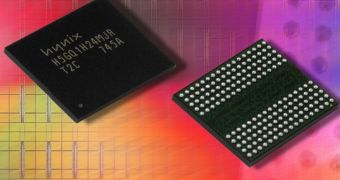Semiconductor manufacturers are constantly trying to improve on the design of their graphics memory modules (which have already reached extremely high processing speeds), in order to relieve the CPU and DDR RAM memory from the stress imposed by graphics-intensive applications and open the road for higher-quality multimedia experiences. And following this trend, Hynix Semiconductor has just announced the development of what seems to be the industry's first 1 Gigabit GDDR5 Graphics DRAM module, which can dramatically improve the processing power of the video card it's installed on.
According to the company, its 1Gb GDDR5 (which actually means 128 MB, if you were wondering, so it's not THAT high a value) memory module is the fastest and highest density graphics memory available, operating at 5Gbps bandwidth and being able to process up to 20 Gigabytes of data per second with a 32-bit I/O. This makes it suitable for those applications that employ high definition video and cinematic and photo-realistic graphics content, a.k.a. next-generation PC games and video applications.
The newly introduced GDDR5 is built on the company's 66-nanometer process technology and designed to minimize power consumption. In addition to its small form factor and power saving characteristics, Hynix's GDDR5 features time delay adjustments, error correction and jitter control technology enabling more robust system designs.
The fifth generation graphics memory GDDR5 improves data processing speed by more than two times that of GDDR3, the current mainstream graphics DRAM device. With its improved speed and power characteristics, GDDR5 is projected to succeed GDDR3 directly (skipping over GDDR4) and dominate the graphics DRAM market from the 2nd half of 2008. And in order to be ready to answer the future market demands, Hynix has also announced that it plans to start the mass production of GDDR5 modules in the first half of next year, which means that its modules might be among the first to be found in the next-generation video cards.

 14 DAY TRIAL //
14 DAY TRIAL //